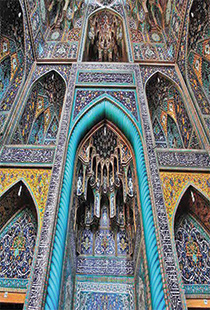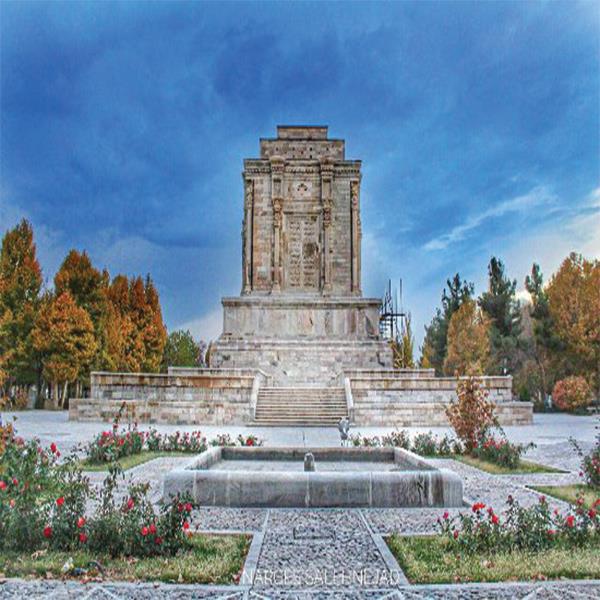Mashhad
Iran’s second largest city and spiritual centre that is located in the northeastern province of Khorasan and has the most magnificent religious places is called Mashhad. An historically important transit city along the Silk Road, which literally means ‘place of martyrdom’, is most famous for accommodating the tomb of Imam Reza, the 8th Shiite Imam, the biggest holy shrine in Iran. This religious city is located in Kashafrud River catchment basin and at the end of the sedimentary plain, between Hezar masjid and Binalood mountains range, at the height of 1050m above the sea level with a mountainous and semi mountainous area which presents a moderate and variable climate.

Description
The most splendid religious places in Iran, Astan Qods Razavi is the symbol of the city where the Islamic art and religion are linked to each other. It is the economic capital and the intercontinental commercial center in the Central Asia. The economic activities of this city are dependent on the services, industry and agriculture; however, it is focused on a services-based economy due to the presence of the passengers and pilgrims who travel to there. This city is also a good place to buy carpets and it's a staging post for travel to Turkmenistan, Afghanistan and the little-touristed Khorasan region.
Before Islam, Tous and Neyshabour were the most famous cities of the region. Mashhad means a place of martyrdom and it was Imam Reza, a descendent of the Prophet Mohammad, who was martyred and buried here in 818 CE. About Khorasan, in Persian, khor means sun and san means place; together it means the place where the sun rises. Today, the sun is rising high in this city as it has been named the religious capital of Iran and annually it hosts over 20 million pilgrims and tourists from around Iran and the world.
History
In the year 202 AH, after the martyrdom of Imam Reza in a place around Toos called Sanabad, that the present city came into existance. Sultan Mahmood Qaznavi built a mausoleum on the shrine. Due to the destruction of the city of Toos in the 7th century AH, people flocked to the this religious city. At first, the area of Toos was inhabited by non-Aryans and some parts of it was conquered by the Arabs during the reign of the Caliph Osman.
Imam Reza Shrine Complex
The Imam Reza Shrine Complex, known as the Haram-e Razavi, dominates the city centre and needs several visits to properly appreciate the scope of its glory. With seven huge courtyards and a total area of nearly 600,000 square metres, by some measures; it is the largest mosque in the world. The millions of pilgrims who flock to the shrine all year round from all over the world endow this part of the city with a decidedly multicultural atmosphere and there is a tangible sense of the spiritual as visitors demonstratively mourn the 8th Imam’s martyrdom. Intricate blue tile work and Arabic calligraphy are virtually omnipresent across the numerous iwans and minarets and an awesome golden dome stands centrally above the shrine itself.
Main Tourist Attractions of Mashhad
There are some attractions in this city such as; Imam Reza Shrine Complex, Tomb of Ferdowsi, who was one of the most famous Iranian poets and the writer of the well-known Shahnameh. Another one is Torghabeh village, located 18 kilometers southwest of the city. As well as, Boq’eh-Ye Khajeh Rabi, Tomb Of Omar Khayyam and Naderi Museum are famous attractions.
Souvenirs
Here is a variety of shopping centers and traditional bazaars selling traditional and religious items; in addition to trendy clothing, household items and high tech goods. Perhaps the most popular souvenir of Mashhad is saffron. It is sold in traditional measurements called mesghal. Other popular items are precious turquoise stones and semi-precious stones, as well as silver and 18 karat gold jewelry.
Foodstuffs include traditional-handmade rock candy (nabat), zeresk (barberries), mixed-hand roasted nuts and seeds (ajeel), dried sour cherries, plums, peaches and golden raisins and fruit rolls. Traditional stone carving and wood cutouts reflecting Iran’s ancient culture and religious background are popular items to buy as well.
Carpets and kilims are another popular purchase.

